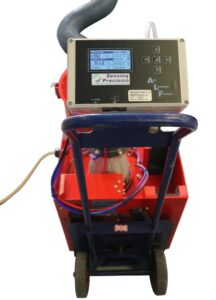Mar 10, 2024 |
The efficient operation of building services which utilises ductwork for heating, cooling and ventilation is dependent upon air tightness – it needs to be tested prior to or during commissioning. This is not always easy as projects come towards completion, there are often numerous different trades competing for the same space and time as the ductwork installer. An additional complication is that ducts are often in voids making them difficult, time consuming and costly to access both to test and to facilitate any modifications required. It is therefore utmost that new ductwork is tested soon after being installed, and having access to duct leakage test machinery that is portable, easy to set up and simple to use, is paramount.
It is possible to predict the likely leakage from ductwork during the system design. As leakage occurs at the seams and joints, it is proportional to the total surface area of the ductwork, taking into consideration of the configuration of the system and the building it serves. This can be compared to actual leakage seen when tested. A key variable here will be air pressure – although there is no precise formula for calculating this, a key guide is that leaks will increase in proportion to pressure to the power of 0.65. Other key variables will be the quality of the design, the workmanship in the installation of the ductwork and the quality of the ductwork itself. The operating pressure will vary throughout the system and, as leakage is related to pressure, the calculations are complex.
Acceptable leakage in good quality systems under normal operating conditions will be in the region of six per cent for low pressure systems (Class A), three per cent for medium pressure systems (Class B), two per cent for high pressure systems (Class C) and just 0.5 per cent for the highest pressure systems (Class D) DW/144
The integrity of the installed ductwork relies upon its manufacture, and that depends upon the proper application of the correct sealant, gaskets or tape, and suitability for operating temperatures up to 70°C. Checks should be made to ensure the ductwork and materials used are suitable for the purpose and satisfy the specified pressure classification. The quality of the installation will be down to subcontractor monitoring and testing prior, during and upon completion.
Conducting a duct leakage performance test is a simple process with the ALF duct leakage tester. A single operative can pressurise and examine the duct system for air leaks, in much the same way that a plumber pressure tests water pipes for leaks. The test involves pressurising the duct system with a high accuracy volume flow measuring device that simultaneously measures air flow and its effect on the pressure within the duct system. The tighter the duct system, the less air you need from the fan to create a change in duct system pressure. Ductwork leakage measurements are used to diagnose and demonstrate leakage problems, estimate efficiency losses from duct leakage, and certify the quality of the duct system. When the air leakage testing is carried out, data can be captured and subsequently saved in a .txt format via SD card or output via mini-USB cable.
All of our air leakage testers utilise three easy to change conical inlet nozzles designed to ISO5801. These precision nozzles, combined with a recently enhanced control POD gives an accuracy of +/-2% of reading throughout the range. Helping with the effectiveness of the job, the enhanced control POD features additional low range pressure cells for both pressure and flow measurement to increase low end accuracy. There are auto zeroing solenoids on both channels to automatically take out any temperature drift in the pressure readings without having to pause/stop a running test or manually zero between tests.
On-site testing for ductwork leakage is only required sporadically, so the unit’s simple operation removes the need to relearn technical skills each time. The closed loop PID control feature allows a closed loop-controlled leakage test to be run. The user selects from the following available test standards SMACNA, EN1507 / 12237 or DW/143. Configurable test parameters include duct size, test pressure, test duration and test class. Once configured appropriately, the ALF control pod will then calculate the allowable max leakage for the test. The control pod will then run the test and pressurize or depressurize the ductwork to the set test pressure and monitor the leakage rate. Based on the performance of the ductwork, the control pod will indicate confirmation of “pass” or “fail” of the ductwork leakage test.
Should the installer run into difficulty, they can also access a range of support videos relating to the ALF range on Sensing Precision’s own YouTube channel.
Sensing Precision’s range of ALF duct leakage testers are compact, lightweight and a totally self-contained all in one unit that can be manoeuvred, connected and operated by a single engineer. Being simple to use also removes the complexity that might be associated with operating a duct work leakage tester and other forms of testing equipment. Our ALF range allows the engineer to be provided with everything needed to test ductwork systems for leakage under both positive and negative pressure.
Not only is the portability and ease of use a big benefit for the user of the air leakage finder, but duct work testing is also capable of providing significant cost saving benefits. Leaking ductwork will impact upon energy costs as well as its ability to provide a comfortable working environment for the building occupants. Air tightness is therefore a consideration in the design, manufacture and installation of the ductwork and HVAC equipment such as Air Handling Units, whether in new build or refurbishment. Testing during and after installation of ductwork or manufacture of equipment is key to ensuring air tightness, the efficient operation of the system, and to control energy costs.
